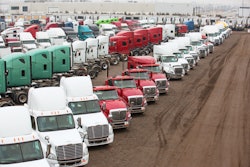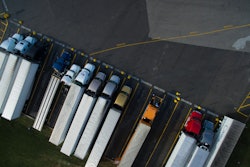Navigating the oceans of imperfect information is called “business.”
The freight industry lives with many unknowns every day. Residual value is usually one of those unknowns. Put simplistically, residual value is what you get for your truck when you turn it over to a new owner or scrap it.
When you buy a truck, you have some projection of how long you will own it, some historical data on how similar trucks have depreciated over time, and a hope that the marketplace doesn’t change unpredictably between today and that future time — but you know it will.
Used trucks exist in that space controlled by supply and demand. The market is cyclical. In some years there are too many used trucks and in other years there are too few – or the wrong ones. Some years there is a rush to buy new trucks, and from experience that means about five years later there will be an oversupply of used ones. Then there is the economy, which can be a rollercoaster ride all its own. There is the technology side of it as well. Some technologies can get a premium in the used market and others have no value. But all of that is somewhere in the future – a future over which a fleet operator has very little control.
Residual value is typically not guaranteed, although there are examples where residual value has been guaranteed when buying a new truck. In those arrangements, the seller is assuming the risk of the market shifting. That business model has a somewhat checkered past. More often, the buyer assumes the risk on where the used vehicle market will price the vehicle in the future.
If you think about it, a good Class 8 production year is between 250,000 and 350,000 trucks, meaning there likely are at least that many used trucks coming into the market as well. There is a lot of data on used truck sales over time. And just as with all the decades of detailed data for the stock market, all that used truck data is potentially completely useless in predicting future value.
If you want some examples of that, look at 2008 to 2010, or 2020 to 2022. It’s a pretty sure bet that predictions of used truck prices made in 2007 and in 2019 were completely wrong in 2009 and 2021. Modeling pricing with some confidence works great if all the variables behave in some predictable way. The real world keeps reminding us that the future is far from predictable.
Some used truck examples to think about
A diesel truck purchased today for use in California, Oregon or Washington will in five years go into markets that are incentivizing zero-emission trucks. How will those markets price the used diesel trucks? Will those trucks have to be moved to different markets to get the best value? Will those Advanced Clean Truck states reward residual value by guaranteeing some value for scrapping that diesel truck at five years as an incentive to buy a new zero-emission vehicle (ZEV)? Will sufficient and affordable renewable diesel or biodiesel exist to maintain the value of the diesel truck? Will the market for ZEVs be so hot that no one wants a five-year-old diesel? Will there be such a demand for glider kits to remanufacture diesels into zero-emission vehicles that a used diesel truck will be valued at a premium (not for the engine but for the rest of the vehicle)? Will retroactive regulations prevent operating a five-year-old diesel? There are a lot of unknowns there.
A battery electric truck purchased today is “new” technology. It likely has incentives or grants helping with the purchase. It may even have needed to sacrifice an old diesel truck to get those incentives. There are effectively no five-year-old used battery electric Class 8 trucks out there in today’s market.
Will the technology live up to its reliability targets? Will the high voltage batteries, cables, connectors and digital electronics hold their performance and value? Will the speed of technology improvement be so fast that a five-year-old electric truck is obsolete? Will anyone incentivize purchasing used battery electric trucks? Will a fleet really need to trade the vehicle at five years, or can it keep it longer than it would its diesel? Will that five-year-old battery electric truck be worth more as parts than as a vehicle? Again, a lot of unknowns.
There are currently no new production Class 8 fuel cell tractors for sale. When will they really be in production? Production hydrogen fuel cell Class 8 vehicles have similar risks to the battery electric vehicles, but layered on top of those are the unknowns regarding a significant drop in hydrogen fuel pricing. Will there be incentives or offsets to help reduce fuel prices?
Autonomous trucks are another example, too. They are not yet available in production, so when will they really be available for purchase? Will anyone want a five-year-old autonomous truck? Is there really a market for five-year-old autonomous vehicles? Are the first owners the only owners? Will the pace of development make older autonomous vehicles less safe than newer ones? How will the market price that risk? Will the autonomous truck need to be stripped down to become a manually driven used one?
Fleets are facing an unprecedented level of change as the industry moves into the next decade. The lack of certainty is a huge challenge in making long-term investment plans for capital equipment.
The only sure thing is that residual values are no sure thing.
Rick Mihelic is NACFE’s Director of Emerging Technologies. He has authored for NACFE four Guidance Reports on electric and alternative fuel medium- and heavy-duty trucks and several Confidence Reports on Determining Efficiency, Tractor and Trailer Aerodynamics, Two Truck Platooning, and authored special studies on Regional Haul, Defining Production and Intentional Pairing of tractor trailers.












